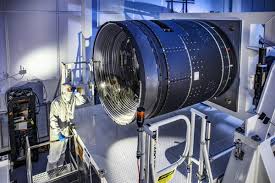Monitoring Desk
NEW YORK: The 3,200 megapixel Legacy Survey of Space and Time (LSST) Camera weighs 3 metric tons and features a lens that measures 1.57 metres (5.1 feet) in diameter.
For reference, the latest iPhone has a 48 megapixel camera that can capture just 0.01 per cent of the detail.
Researchers and engineers at the SLAC National Accelerator Laboratory in the US who built the camera say it will offer unprecedented insights into some of the universe’s biggest mysteries.
Once it is placed on top of a telescope at the Rubin Observatory in Chile, astronomers will use it to hunt for dark matter, which makes up around 85 per cent of the matter in the universe.
“We will soon start producing the greatest movie of all time and the most informative map of the night sky ever assembled,” said Željko Ivezić, a professor at the University of Washington and director of Rubin Observatory Construction.
The camera’s resolution is so high that it would take hundreds of ultra-high-definition televisions to display just one of its images at full size, according to Aaron Roodman, deputy director of the Rubin Observatory.
“Its images are so detailed that it could resolve a golf ball from around 15 miles away, while covering a swath of the sky seven times wider than the full moon,” Professor Roodman said.
“These images with billions of stars and galaxies will help unlock the secrets of the universe.”
Astronomers also plan to use the LSST camera to spot previously undocumented supernovae stars, as well as improve our understanding of the Milky Way galaxy and our own solar system.
The camera’s sensitivity should allow it to produce the most detailed map of our galaxy ever produced.
“There are so many scientists here at SLAC and around the world who will find something valuable in the data this camera will produce,” said Risa Wechsler, a cosmologist who directs the Kavli Institute for Particle Astrophysics and Cosmology at SLAC and Stanford University.







